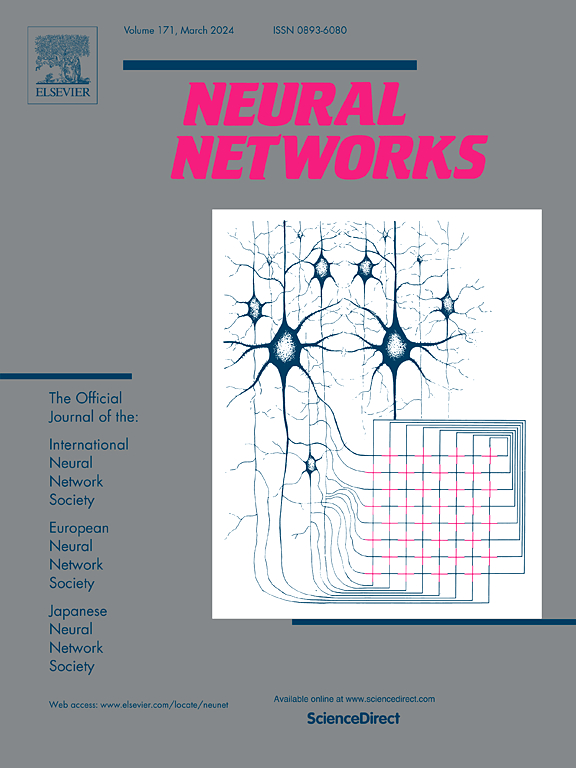配对还是高阶?知识图嵌入的自适应图框架
IF 6
1区 计算机科学
Q1 COMPUTER SCIENCE, ARTIFICIAL INTELLIGENCE
引用次数: 0
摘要
知识图(Knowledge graph, KGs)将实体描述为节点,将连接描述为边,在人工智能应用中得到了广泛的应用。然而,知识图谱往往存在不完整性问题,严重影响下游应用。知识图嵌入(KGE)技术通过将实体和关系编码为向量来解决这一挑战,允许使用这些表示进行推理和计算。图卷积网络(GCNs)是知识图嵌入技术的重要模型。GCN方法通过计算实体和相邻节点之间的成对关系来捕获KG的拓扑结构特征。尽管GCN模型已经取得了优异的性能,但仍然存在三个主要挑战:(1)有效解决多层GCN模型中知识图表示学习的过度平滑问题;(2)获取实体与相邻节点之间超越成对关系的高阶信息;(3)有效整合实体的成对特征和高阶特征。为了解决这些挑战,我们提出了一种自适应图卷积网络模型,称为PHGCN(成对和高阶图卷积网络),它可以同时集成成对和高阶特征。PHGCN通过以下方式解决上述三个挑战。(1)我们提出了一种层感知的GCN来克服聚合成对关系时的过度平滑问题。(2)采用简单复杂神经网络从知识图中提取高阶拓扑特征。(3)引入了一种自适应聚合机制,有效地集成了成对特征和高阶特征。我们在四个基准数据集上的实验表明,PHGCN优于现有方法,获得了最先进的结果。使用简单复杂神经网络提取高阶特征的性能提高是显著的。在FB15k-237数据集上,PHGCN提高了1.5%,而在WN18RR数据集上,PHGCN提高了6.1%。本文章由计算机程序翻译,如有差异,请以英文原文为准。
Pair-wise or high-order? A self-adaptive graph framework for knowledge graph embedding
Knowledge graphs (KGs) depict entities as nodes and connections as edges, and they are extensively utilized in numerous artificial intelligence applications. However, knowledge graphs often suffer from incompleteness, which seriously affects downstream applications. Knowledge graph embedding (KGE) technology tackles this challenge by encoding entities and relations as vectors, allowing for inference and computations using these representations. Graph convolutional networks (GCNs) are essential knowledge graph embedding technology models. GCN methods capture the topological structure features of the KG by calculating the pair-wise relationships between entities and neighboring nodes. Although GCN models have achieved excellent performance, there are still three main challenges: (1) effectively solving the over-smoothing problem in multi-layer GCN models for knowledge graph representation learning, (2) obtaining high-order information between entities and neighboring nodes beyond the pair-wise relationships, and (3) effectively integrating pair-wise and high-order features of entities. To address these challenges, we proposed an adaptive graph convolutional network model called PHGCN (Pair-wise and High-Order Graph Convolutional Network), which can simultaneously integrate pair-wise and high-order features. PHGCN tackles the three challenges mentioned above in the following ways. (1) We propose a layer-aware GCN to overcome the over-smoothing problem while aggregating pair-wise relationships. (2) We employ simplicial complex neural networks to extract high-order topological features from knowledge graphs. (3) We introduce a self-adaptive aggregation mechanism that effectively integrates pair-wise and high-order features. Our experiments on four benchmark datasets showed that PHGCN outperforms existing methods, achieving state-of-the-art results. The performance improvement from using a simplicial complex neural network to extract high-order features is significant. On the FB15k-237 dataset, PHGCN achieved a 1.5% improvement, while on the WN18RR dataset, it improved by 6.1%.
求助全文
通过发布文献求助,成功后即可免费获取论文全文。
去求助
来源期刊

Neural Networks
工程技术-计算机:人工智能
CiteScore
13.90
自引率
7.70%
发文量
425
审稿时长
67 days
期刊介绍:
Neural Networks is a platform that aims to foster an international community of scholars and practitioners interested in neural networks, deep learning, and other approaches to artificial intelligence and machine learning. Our journal invites submissions covering various aspects of neural networks research, from computational neuroscience and cognitive modeling to mathematical analyses and engineering applications. By providing a forum for interdisciplinary discussions between biology and technology, we aim to encourage the development of biologically-inspired artificial intelligence.
 求助内容:
求助内容: 应助结果提醒方式:
应助结果提醒方式:


